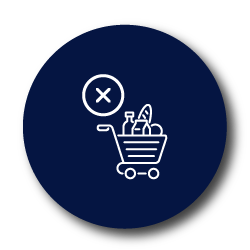Retail shrinkage is something all retailers experience no matter what products they sell. That’s why it’s critical to understand it. By understanding what retail shrinkage is, you can combat it. More than that, you can minimize any associated risks.
In this article, we unpack retail shrinkage for what it is. We also explain why retail shrinkage increases during holiday seasons, and how you can combat it.

What is retail shrinkage?
Retail shrinkage refers to your inventory decreasing either through shoplifting, employee theft, supplier fraud/error, cashier errors and other reasons. In this article, we will focus on intentional shoplifting rather than accidental shoplifting.
As the descriptor implies, ‘accidental shoplifting’ refers to when a customer forgets to pay for a product or passes the pay point in possession of the goods unknowingly. According to a legal insurance brand, Law for All, accidental shoplifting is not uncommon in South Africa, with some victims being arrested, but then later released on bail.
As for intentional shoplifting, let’s consider the United States. According to a 2018 survey by the National Retail Foundation, inventory shrink cost the US economy $46-billion.
A typical example of such theft includes a person hiding goods on his/her person with the objective being to conceal it from your staff and security.
Another example is when a customer pretends to show goods to an accomplice who is waiting outside. The customer will walk outside or as close to the exit as possible without drawing attention, to show the accomplice the goods. Then, when no one is paying attention, the accomplice will take some of the goods and the customer will return the rest and leave. Within the apparel and accessory industry, shoplifting has become even more advanced, as a customer can enter the store, pretend to fit a garment or accessory, and just walk out wearing the item, making no attempt to conceal it.
Shoplifting has become so advanced that concealing the goods won’t even catch the security’s attention.
According to the South African Department of Agriculture, examples of concealment include, but are not limited to; concealment of goods under clothing, concealment of goods in handbags, backpacks, and personal shopping bags. Concealment of goods in shopping bags of purchases from another store and “false wrapping”.
False wrapping is the act of concealing expensive items in the wrapping of less expensive goods. For example, hiding a watch in a box of cereal.

Why does retail shrinkage increase during the holiday seasons?
Loss Prevention and Shrinkage Control consulting firm, Jack L. Hayes International publishes an annual retail theft survey. In the most recent survey, more than 348,000 shoplifters and dishonest staff in the US were caught stealing in 2019 with only 21 of these retailers being able to recover some of the stolen goods.
Shoplifting is a constant issue for most retailers, but as the holiday season approaches, shoplifting incidents increase dramatically.
This is due to a few reasons. There could be less staff on the floor, because of the increase in shoppers who need assistance with last minute shopping. Shoplifters view this period as a low risk crime gap with a high payout, if successful.
A targeted category could have low store traffic due to traffic moving to popular holiday essentials. In South Africa, the norm is to fine the guilty party for between R1000 - R1500. Nonprofit consumer advocacy organization, Public Citizen, has noted in a report that retailers are backing harsher punishments for shop theft.
For 2020, COVID-19 can play a big role in shoplifting increasing this festive season.
According to Security Tags, it's not only the high-value items that attract shoplifters. Yes, expensive items can and will still fall victim to shoplifting due to the high reselling value. However, if you have products that aren’t sufficiently protected, you can fall victim.
Another reason why shoplifting increases during holiday seasons is because retailers tend to display higher priced items in their front of shop. That’s in a bid to generate excitement from their customers, encouraging impulse buys and enticing them to increase their in store spending. It also catches shoplifters attention who are looking for opportunities to shoplift.

How can you combat retail shrinkage?
While the holidays brings with it an increase in shoplifting, there are many ways in which you can combat it. Or, at the very least, reduce it.
1. Change store layout and floor plan
The first method is to change your store layout and floor plan.
If you are a smaller retailer, it will be easier to change your departments and shelves in a way that it can be monitored all the time without making innocent customers uncomfortable.
For larger retailers, it is important to bring as much attention to the targeted products or category. By moving this category to a hot spot (high traffic areas) within your store, you can increase the chance of the shoplifter being spotted or being too cautious to try and steal a product.
2. Install cameras and employ extra staff
Installing cameras in visible sections also warns the shoplifter that they will be caught and this decreases your chances of encountering retail shrinkage. It’s critical to ensure that you test the cameras first and are satisfied that it's easy to identify any potential shoplifters.
Meanwhile, by employing extra staff during holiday seasons, you will make it difficult for a shoplifter to get away with this crime, because he/she will be monitored the whole time if they act suspicious.
3. Anticipate movements of shoplifters
Ensuring all customers use one entrance and one designated exit will enhance all efforts to monitor the potential shoplifters movements and make it difficult to disappear within an incoming crowd. You can also have your security guards checking anyone leaving with a bag.
If your store has restrooms, place them strategically behind the counters to avoid shoplifters quickly hiding a product in the restroom. You can also place cameras near the entrance to your restrooms.
4. Use security tags
If you are selling higher priced items, you can implement a security tag system that has to be removed at the pay point. If not removed, it will set off an alarm when a shoplifter leaves the store.
You can also display only one item on the shelf or only the box of the item. Then, when the customer proceeds to the pay point, a staff member will bring a new box containing the product. A relevant example of this is an expensive breast pump stocked in speciality stores. This product is usually shoplifted to be returned for a cash refund as it is such an expensive product.
5. Turn to a third-party software specialist
Besides the actions you can take in-store, you can also use specialised software such as DotActiv.
By implementing data-driven planograms, you will have well displayed and neat shelves, which will make it easier to identify when products are missing.
DotActiv is a category management services-first company and by adding a qualified space planner to your merchandising team, in collaboration with assortment planning, you can determine which products or ranges to discontinue when a category gets congested. By doing so, your planograms will be neater and the risk for shoplifting will decrease.
The sad reality is that if you are a general merchandiser and infant formula is one of the product categories that you sell, you probably would’ve already experienced retail shrinkage of infant formula due to shoplifting. This is an expensive product that is highly sought after by many mothers who are unable to breastfeed.
To combat this issue, you can use assortment planning to determine which brands and products can be taken out of the category to make the planogram less congested. You can also use DotActiv’s integrated floor planning function to move the category to space in your store that experiences higher foot traffic.
When implementing these steps, it is important to not move the category out of the relevant department completely. You must also keep in mind that moving the category might cause traffic congestion in the aisle of the high trafficked space.
Another way DotActiv can assist is through the implementation of assortment plans in collaboration with cluster optimization. By doing this, you can determine which products to add to which stores or clusters.
For example, a pharmaceutical retailer might only stock expensive non-prescription remedies at higher LSM stores and clusters, where the spending power of the consumer is higher. This will reduce the risk of these products being shoplifted for personal use or in most cases reselling.
Conclusion
Holiday seasons are meant to be enjoyed. If the right processes and measures are in place, you can enjoy it without being concerned about increasing your retail prices to make up for the loss due to shoplifting.
Learn more about DotActiv's category management software and professional services or book an complimentary meeting with a DotActiv expert today.


